Can You Use Craft Paint for Acrylic Pouring?
Craft paints are by far the cheapest and easiest acrylic paints to get a hold of. Every craft store has a few different brands of craft paints and large retailers like Walmart and Target also carry them. These paints get used for many different hobbies and projects.
Can you use craft paints for acrylic pouring? Craft paints can absolutely be used for acrylic paint pouring. However, craft paints do not have as much pigment or as high-quality binder as artists’ acrylic paints, so don’t mix them with as much pouring medium. The recommendation is to mix one-part pouring medium to one-part craft paints (1:1).
In this blog post we’ll review in more detail how craft paints are made, the most common craft paint brands, and some best practices when using them for fluid acrylic pouring.
What are Craft Paints?
All acrylic paints are made of three main materials: pigment, acrylic polymer, and water. The pigment and acrylic polymer get mixed in with the water and create an emulsion (one substance suspended in a liquid).
The water in the paint is used to help change the consistency of the paints. Heavy body acrylics have less water than soft body acrylics. Craft paints generally have more water than other forms of acrylic paints. This greater portion of water in craft paints tends to give them a runnier consistency.
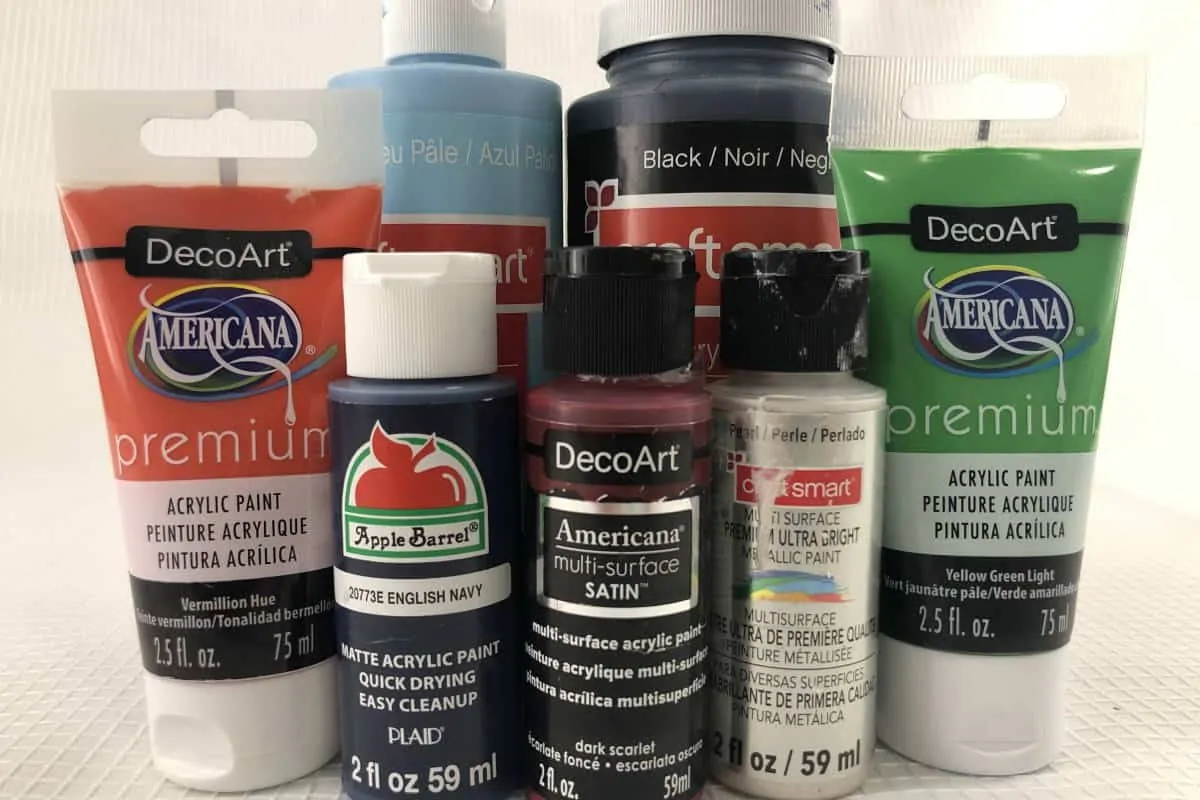
Pigment Load
The ingredients used in craft paints are usually chosen based on their cost more than their quality. This means that there is less color pigment, or load, than regular acrylic paint.
Many of the pigments used are synthetic and do not create pure colors like some more expensive pigments would. Many of the colors with “hue” in the name (eg. cadmium red hue) use synthetic pigments.
With less pigment, you can’t “cut” or add as much medium/water because diluting the paint will the vibrancy of the color.
In many cases, craft paints don’t use normal color names, like cadmium red, because in many cases craft paints are a combination of different pigments and they don’t want to misrepresent the colors they offer.
Binder Quality
The binder used in craft paints is also not of the same quality as they are in regular acrylics. If you are going to extent craft paints, use a pouring medium that has its own binder like floetrol, glue-all, or any professional pouring medium.
Using too much water with craft paints will cause them to flake and peel when they dry because there is not enough binding power between the plastic polymer molecules after the water evaporates.
Cost
Craft paints are frequently sold in 2-ounce containers and are usually priced in the $50 – $1.00 per ounce range. The cost per ounce generally goes down with the size of the container that you purchase.
Some craft paints meant to be used in educational settings like Mont Marte, Sax, and Sargent are also sold in much higher volumes.
Using Craft Paints in Acrylic Pouring
As mentioned in the introduction, craft paints can definitely be used for acrylic pouring and are a great way to learn without breaking the bank.
When using craft paints for acrylic pouring, do not mix more than one-part pouring medium to one-part paint. This will ensure that when the paint dries it will be less likely to crack, craze, or peel from the painting surface.
It is recommended that a protective coating that includes UV blockers be applied to any pour painting with craft paints to help keep maintain color vibrancy for as long as possible. UV will degrade lower quality pigments, similar to the affect sunlight has on bumper sticker colors over time.
Review our blog post below about acrylic pour dry times to make sure enough time is allotted to drying and curing a painting before finishing with a protective coat.
Beginner Pouring Medium Recipe
If you are just starting out with acrylic paint pouring, try using white Elmer’s Glue all as your first pouring medium.
Mix 70% glue to 30% water. Then take one-part of this glue mixture to one-part of your favorite craft paint. For more information visit our blog post about pouring with PVA glue or watch our video below.
Common Craft Paint Brands
There are quite a few brands that make craft acrylic paints. We will be highlighting a few that are commonly used in the paint pouring community.
Apple Barrel
Apple Barrel paints, made by PLAID, are one of the most common craft paints in the United States. They come in matte, satin, and gloss finishes and have a ton of different colors. These paints can be found at Amazon and Walmart.
Blick
Blickrylic student acrylic paints are the craft/educational line of paints from Blick. These paints come in over 30 different colors including metallic and fluorescent colors. You can buy them in sizes from a pint (16 oz.) to a half-gallon (64 oz.) from any Blick Art retail store or on the Blick website.
Craft Smart
Craft Smart is another popular craft acrylic paint brand. Their paint selections include matte, satin, and gloss finishes with a huge selection of colors. Glow-in-the-dark, metallic, and fluorescent colors can also be found. Purchase Craft Smart craft acrylic paints at Amazon or Michael‘s.
Darice
Darice is a wholesaler for arts and craft supplies based in Ohio, USA. Paint pourers don’t generally need wholesale amounts of craft paints but you can purchase these paints on Amazon for a reasonable price.
DecoArt
DecoArt is a staple in the arts and crafts arena. They have craft paints (Americana), enamels, pouring mediums, and so much more. The DecoArt Extreme Sheen and Satin Enamels are frequently used by experienced pourers to create some of the beautiful artworks you see on Instagram, YouTube, and Pinterest.
DecoArt can be purchased from Walmart, Amazon, Blick and many other crafting retailers.
FolkArt
FolkArt is another brand under the PLAID umbrella. These paints come in a variety of different colors and finishes including satin, matte, and gloss. We highly recommend the Glitterific and the Metallic paints from FolkArt.
Purchase FolkArt from Amazon, Walmart, and Michael’s stores.
Martha Stewart
Who hasn’t heard of Martha Stewart? And of course, she has her own brand of craft acrylic paint. This paint is a little on the expensive side, but it does come in some colors that you don’t see from other brands.
Mont Marte
We were recently introduced to Mont Marte paint by Julie on the Pouring Your Heart Out YouTube channel. She creates amazing nature-inspired pictures with beautiful cells. These paints come in larger containers.
Purchase Mont Marte craft acrylic paints on Amazon.
Sargent
Sargent acrylic great beginner paints that come in larger containers at really great prices. These are geared toward the educational space but are perfect for learning acrylic paint pouring. One of the starter packs will have you painting for months.
Find Sargent craft acrylic paints at Walmart and Amazon.
Conclusion
Craft acrylic paints are a great introduction to acrylic paint pouring with an exorbitant cost. They are easy to find, relatively inexpensive, and have there is a huge selection of colors.
Once a certain comfort level is reached with craft paints, we recommend you expand into artist level paints for even more depth of color. For a list of our recommended paints to use for fluid pouring see our page for Best Acrylic Paints for Pouring.

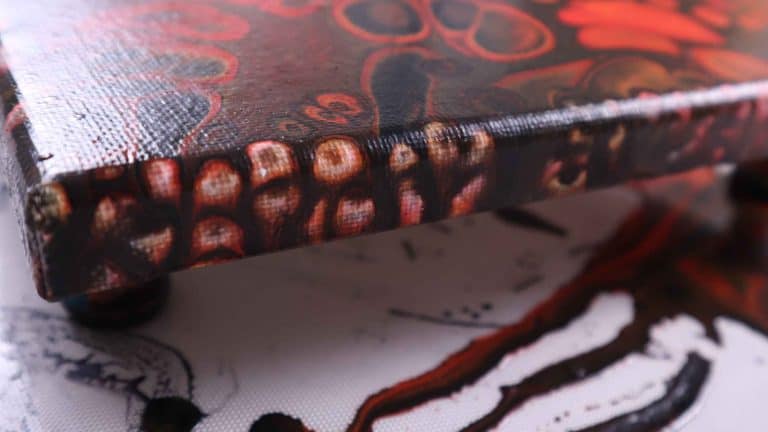


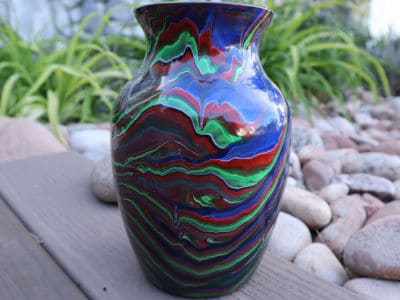
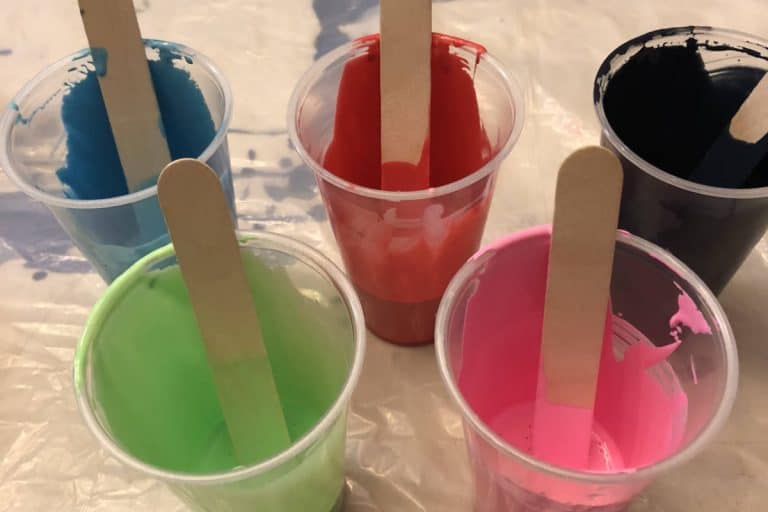
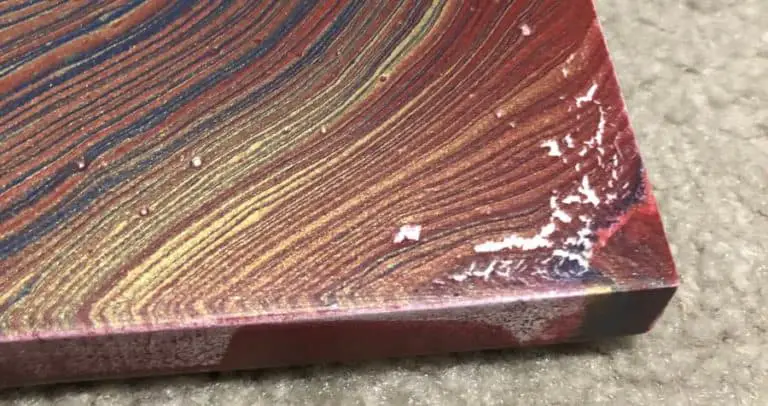
I’m pretty new to the craft here and have started off using cheap apple barrel paints. I started off using a 1:1 paint and medium (floetrol) but didn’t have great results, the paint was way too thick. I read somewhere else to try 1:3:1 paint, medium, and water and have had better results with that.
For craft paint, the more you dilute the paint the less vibrant the colors are. I usually do 1:1 and then add a little water. That is a personal preference on my part and my advice would be to keep doing what works for you. Some colors work great like that. If you notice a color totally disappearing in your painting you probably want to dilute that one less. The transparent colors will be affected quicker than the opaque ones in my experience.
I am not able to get large cells. I’m barely able to get small cells. I mostly just get a marbled canvas of colors.
I do not use a torch. and my surface is level.
my recipe:
2 parts floetrol
1 part paint
3 parts GAC 800
1-2 drops pure dimethicone
I look forward to your suggestions
thank you
violet
Will you try something for me? I think it might help. Use 1 part paint, one part floetrol and 1 part GAC 800. Mix well for a few minutes then let it sit for at least 15 minutes.
Your consistency should be that when you pull out your stirring utensil from about 1 inch off the surface of the paint, the paint drizzles in and creates a mount that lasts for a second or two and then fully integrates into the paint. Sometimes it looks like it is creating a mount on top of a mount and then disappearing.
After the 15 minutes add your drop of dimethicone per 2 oz of paint (give or take) and stir three or four times. Then make your dirty pour cup (I am assuming that is what you are doing). Let is sit in the cup for a minute before turning it over.
Let me know how that works?
Hi David-thank you for your time in creating articles that are informative and to the point without a lot of flowery opinions LOL. I’ve been pouring for a few months and feel I “study“ a lot of information but I like the clarifications you give on why what you’ve founds works for you works. It’s super important!
Thanks Tania. I think a lot of success is a result of constant trial and error with acrylic pouring. I hope I can save people some time by helping them narrow the scope of their trials and learn from my mistakes and my observations.
Hi, just wondering if I want to do an acrylic pour with decoart paints and decoart pouring mediums, is the ratio 1:1 for every colour? I find that the colour white seems to crack every so often but the others work well with that ratio. Do I increase the white paint at 2:1 or the medium to avoid the cracks on the white?
Thanks
Maria
I haven’t liked the Decoart white at all. I usually go with Blick or Amsterdam for white depending on what I am doing. I usually do 2:1 for pouring mediums, including Decoart. I did a video on this pouring medium on my YouTube channel that might help.
where do u get Amsterdam paint from
I buy it at Michael’s or online (Amazon, Jerry’s Artarama, Blick, etc).
Maria, it is not just Deco Art white, it is all craft-level white acrylic paint. It is the one color that almost all pourers will tell you to spend a little more money on and get a higher quality, artist grade brand. But I think because we tend to use a lot of white in pouring which increased our costs a lot of pourers turned to house paint and I believe that’s how some of these new effects like “Bloom” came into play. I could be wrong, but that’s my theory.
The other reason craft whites crack is because we know they have less pigment, so we don’t add as much water or mediums, so it remains thicker causing it to take longer to dry. You see it’s not really the white that is cracking, the white causes the other colors to crack because they dried first on top of the white and when the white dries it moves (cracks) the other already dry color.
Well said. Interesting observation about the house paint issue. Problem solving like this does tend to help out innovation.
What’s the ratio of paint, floetral, silicon, water when using heavy body paints (Utrecht and Blick brands)? My first mix up was using leftover house paints created more marbling and tiny, tiny cells. I feel that I added too much water to thin it out.
1 part paint to 2-5 parts medium depending on how bright you want your colors. With heavy body paint you want to mix a tiny bit of Floetrol at a time until you have about a 1:1 ratio and then you can add the rest. Otherwise the paint doesn’t mix really well. To start out with I’d do 1:2 and then see how that turns out.
Add water until you get your desired consistency. For cells you probably want where drizzling it off leave a slight mount and drizzling it in a circle on the top it goes away after 3 seconds or so. If you make it too thin the silicone is just going to turn your cells in to a dirty mess. Don’t torch till after you have tilted off two size (or half the painting). That way your cells don’t form till later and they don’t get too misshapen due the tilting. Torch at the end again if you want small cells to come up.
Use one small drop of silicone per 2 ounces of mixed paint.
Hi Mr.David
I think I know my answer already but is it the craft paints in a mix for Dutch pour ? I watched several video’s with paint and water only for pour, but mine does not turn out so good. Is it the craft paint do you think?
Craft paint does not work well for Dutch pours in my experience. Some of the specialties like 24k gold or metallics can but otherwise the pigment to binder ratio is just too low.
FolkArts, Ltd, Studios, We have not found any craft/ artist acrylic that have enough pigment. Do we need to swith to Golden Acrylic Paints?
I use student level acrylic (Liquitex Basics, Artist’s Loft, Amsterdam, etc.) and they work great. Golden is great and very pigmented it is just outside the budget of most of the artists I work with Michael.
You said above, that craft paint does not work well for Dutch pours.
Which pours work well or at least, better, with craft paints?
I love watching your videos to learn and sometimes just to relax. I think all tutorialists should take an approach similar to yours. Thank you for your contribution
Straight pour, ring pour, flip cup. Just make sure you don’t use more than one metallic or pearlescent paint or it muddies too quickly.
I have several partially used tubes of acrylic paint that are four or five years old. Can I use them to pour if I use less pouring medium? Some are awfully thick
Also, I have poured some coasters and there appears to be a “crazing” going on. Not bad, but not what I’m looking for. Any suggestions? I’d love to send a pic so you can take a look.
You can use my contact us link on my website to send pictures.
With the paint, as long as it isn’t separated and dry it should work find. Just make sure you use a little bit of medium at a time when you are first mixing (only drops) to make sure it doesn’t clump when mixing.
Can you use craft paint for your base coat on the canvas? Since you need a much larger amount of paint mix to cover the canvas vs your other colors. I just tried a bigger canvas dutch pour and when it finally dried the white base was all full of cracks – I know it was too thick but still frustrating to see. I used Apple Barrel white acrylic mixed with floetrol 2 to 1 (2 parts floetrol)
You can. The problem with craft and lower quality paints is they have lots of fillers and less expensive pigments which makes them very lightweight (not dense). Higher quality paints that are more dense will “fall” through the base coat and you might not get as much of the higher quality colors showing as you like. That being said, test and see how it works on a small canvas before you fully commit.
Also, apple barrel white is notofious for cracking. I made a video about that on my youtube channel.
Is there anything you can add to a jar of acrylic paint to thin it out because it’s a little old and chunky)-: ? Thanks, and love your style!
You can use any pouring medium or just water. You want to make sure you stir a ton and let it rest and stir. You might have to strain it also if you have dry clumps.
I would like to pour paint clay flower pots with the students in my class, very basic like from a cup because they are all pretty handicapped and cannot do anything unless it’s hand over hand. I want to make my own using craft paint , could you please give me some pointers
1 part craft paint, 1 part glue, + water to consistency.
I would pain the pot first so it doens’t absorb so much of the water when you pour over them and so you don’t have to make sure every inch gets covered by pour paint.
Hi David great website and information thank you.
My acrylic is settling unevenly, as in I have ridges in the finished item!
These ridges appear to be at the ends of the ‘blown’ acrylic and I would say more often where the paint has darker pigment.
I’m thinking the my mixture is too thick?
Any advice please?
John F UK
Definitely a consistency issue between the different paints you are using. If you are using a hosue paint base and other paints on top you will always get this. it will never be smooth.
I recently found Mont Marte signature acrylic color paints in 2.5oz bottles at my local Menard’s store.
While I myself have never done an acrylic pour myself, I am going to give it a try! I have spent a lot of time watching my mom and aunt create pour paintings, after I taught them how to pour soap creatively, so many concepts and materials are similar.
I am curious to know if anyone is knowledgeable regarding the different types of titanium dioxide? I know I can purchase both water soluble and oil soluble versions for soap, but I am unaware of the difference, because it comes as a powder. I also use many micas, oxides, lakes and dyes, along with natural pigments like alkanet, indigo, charcoal and clays; and some things, like the lakes are oil soluble and the dyes are water soluble. In saying this, it’s important for me to remember not to mix the water soluble colors in candle wax or lip balms or anhydrous products (things that contain only oils and no water), because it doesn’t work;)
The other reason I brought up the creation of candles, is because candle companies also sell UV inhibitor powder, but I am not sure if this can be used in a water based acrylic pour creation, without using an additional amount of an emulsifier.
Ps. What exactly is / are the ‘acrylic polymers’ used when making paints? I love technical information and would love to know if these polymers are the same as the ones used in hair care products, just like using dimethicone & cyclomethicone!
Anyway, my objective is to create a pour that resembles the colors of an abalone shell, but I am not sure what type of pour that would entail? I am not necessarily looking for cells, because I want to be able cut the dried paint into long 1/2″ wide strips, so I can use each as a “pinstripe” by gluing the dried strips onto pieces of furniture of an old bedroom set I have. I thought abalone, because I already painted the set royal blue and peacock / teal green. If this project doesn’t work, I have a simple peacock type stencil I made that I will try.
So I set up a large baking sheet pan (62 x 42 cm), lined it with freezer paper and feel that I should make the depth ~5mm (0.5cm), and used the calculator to calculate the area / amount of paint I need. Whether I use a black (preferred for this project) or white ‘pillow’ paint, how much of this am I supposed to use? Should I use the same amount as equal to the other paints, or is this supposed to be a part of the other paints? Also, can I add things to this base, like an iridescent mica? Please advise!
I am really enjoying reading the information shared on this sight, and lastly want to say thank you! Again, I really appreciate the “dummied down” technical explanations, because I get in these arguments with my aunt when she gives me some stupid answer regarding why her paintings are constantly cracking, like the base paint and top coats are drying at different times. The answer t9 this dilemma doesn’t have anything to do with different densities, does it?
Thank you for your time!!! -J
Hopefully I answer all of your questions.
– I don’t know the technical differences between the titanium oxide pigments. haven’t done a lot of research there.
– acrylic polymer is a synthetic resin made from acrylic acid esters. Dimethicone is a silicone-based polymer. (googled the answer cause my explanation wasn’t as concise)
– For a peacock pour you could to a flip up, a staright pour (my preferred technique), or a swipe. Maybe even a strainer pour.
– Cracking generally happens because you use low quality paint (especially craft white paint), you leave too much paint on the canvas, or you have an environment that causes the outside layers to dry way more quickly than the inside (fan blowing on the painting or extermely hot/cold temps etc.)